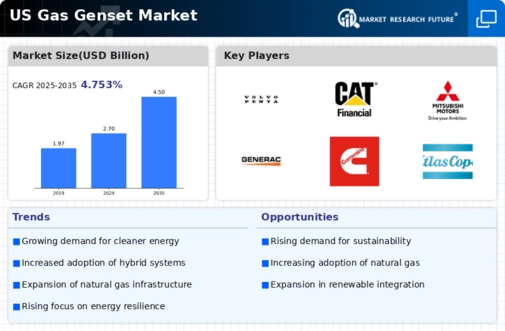Rising Energy Demand
The gas genset market is experiencing a surge in demand due to increasing energy requirements across various sectors in the US. As urbanization and industrial activities expand, the need for reliable power sources becomes paramount. The US Energy Information Administration (EIA) projects that electricity consumption will rise by approximately 1.5% annually through 2025. This growing demand for energy is likely to propel the gas genset market, as these systems offer efficient and flexible power solutions. Furthermore, the shift towards cleaner energy sources aligns with the operational characteristics of gas gensets, which emit fewer pollutants compared to traditional diesel generators. Consequently, the gas genset market is positioned to benefit from this upward trend in energy consumption, as businesses and municipalities seek sustainable and dependable power generation options.
Cost-Effectiveness of Natural Gas
The economic advantages associated with natural gas are significantly influencing the gas genset market. Natural gas is often more affordable than other fossil fuels, which enhances the operational efficiency of gas gensets. According to the EIA, the average price of natural gas in the US has remained relatively stable, making it an attractive option for power generation. This cost-effectiveness is particularly appealing to industries that require continuous power supply, such as manufacturing and healthcare. Additionally, the lower maintenance costs associated with gas gensets compared to diesel generators further contribute to their appeal. As businesses seek to optimize their operational expenditures, the gas genset market is likely to see increased adoption, driven by the financial benefits of utilizing natural gas as a primary fuel source.
Increased Adoption in Remote Areas
The gas genset market is seeing increased adoption, particularly in remote and off-grid areas where access to reliable electricity is limited. Gas gensets provide a practical solution for power generation in these regions, offering flexibility and ease of installation. The US Department of Energy has highlighted the importance of decentralized energy systems, which can enhance energy security and resilience in underserved communities. As rural electrification initiatives gain momentum, the demand for gas gensets is likely to increase, driven by their ability to deliver consistent power in challenging environments. This trend not only supports local economies but also contributes to the overall growth of the gas genset market, as more stakeholders recognize the value of reliable energy access.
Government Incentives for Clean Energy
The gas genset market is benefiting from various government incentives aimed at promoting clean energy solutions. Federal and state programs are increasingly offering tax credits, grants, and rebates for the installation of gas gensets, which are recognized for their lower emissions compared to traditional power generation methods. For instance, the US government has implemented initiatives that encourage the transition to cleaner energy technologies, which includes the use of natural gas. These incentives not only reduce the initial investment costs for businesses but also enhance the overall attractiveness of gas gensets as a viable power solution. As more organizations take advantage of these programs, the gas genset market is expected to expand, driven by the dual benefits of financial support and environmental responsibility.
Technological Innovations in Genset Design
Innovations in the design and technology of gas gensets are playing a crucial role in shaping the market landscape. Advances in engine efficiency, control systems, and emissions reduction technologies are enhancing the performance of gas gensets. For example, the integration of smart technologies allows for real-time monitoring and optimization of power generation, which can lead to significant operational savings. The gas genset market is likely to see increased interest as manufacturers continue to develop more efficient and environmentally friendly models. Furthermore, the trend towards hybrid systems, which combine gas gensets with renewable energy sources, is emerging as a promising avenue for future growth. These technological advancements not only improve the reliability of gas gensets but also align with the broader shift towards sustainable energy solutions.






















Leave a Comment